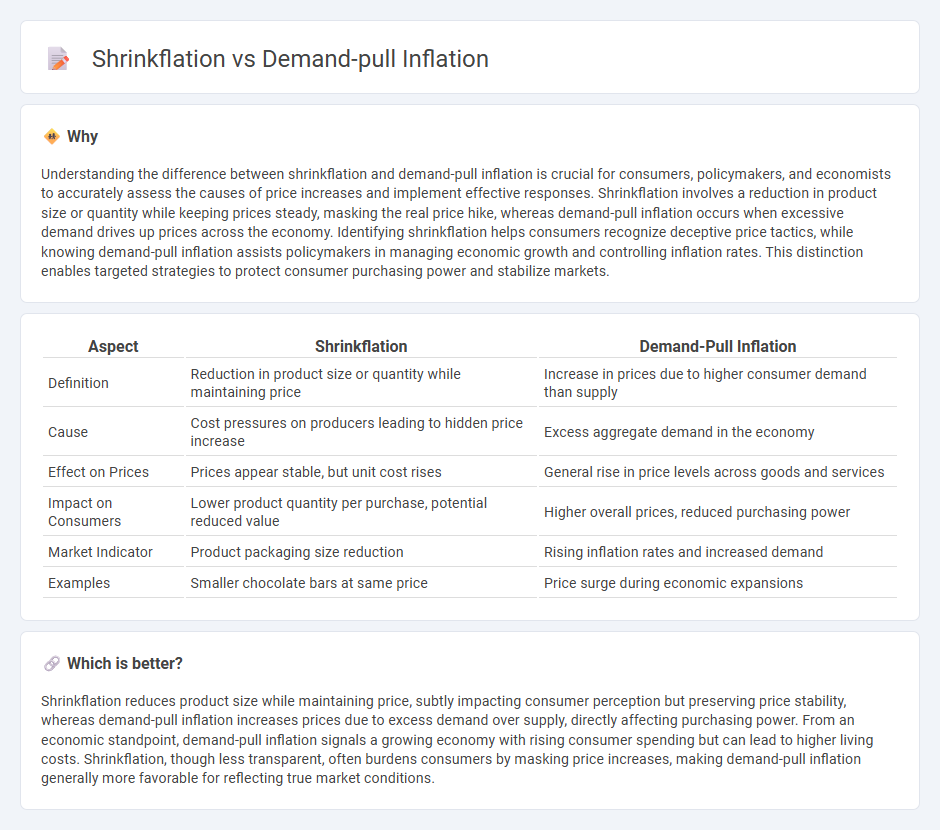
Shrinkflation reduces product sizes while maintaining prices, eroding consumer value and subtly impacting purchasing power. Demand-pull inflation occurs when aggregate demand surpasses supply, driving prices upward across the economy. Explore the distinct effects of shrinkflation and demand-pull inflation on market dynamics and consumer behavior.
Why it is important
Understanding the difference between shrinkflation and demand-pull inflation is crucial for consumers, policymakers, and economists to accurately assess the causes of price increases and implement effective responses. Shrinkflation involves a reduction in product size or quantity while keeping prices steady, masking the real price hike, whereas demand-pull inflation occurs when excessive demand drives up prices across the economy. Identifying shrinkflation helps consumers recognize deceptive price tactics, while knowing demand-pull inflation assists policymakers in managing economic growth and controlling inflation rates. This distinction enables targeted strategies to protect consumer purchasing power and stabilize markets.
Comparison Table
| Aspect | Shrinkflation | Demand-Pull Inflation |
|---|---|---|
| Definition | Reduction in product size or quantity while maintaining price | Increase in prices due to higher consumer demand than supply |
| Cause | Cost pressures on producers leading to hidden price increase | Excess aggregate demand in the economy |
| Effect on Prices | Prices appear stable, but unit cost rises | General rise in price levels across goods and services |
| Impact on Consumers | Lower product quantity per purchase, potential reduced value | Higher overall prices, reduced purchasing power |
| Market Indicator | Product packaging size reduction | Rising inflation rates and increased demand |
| Examples | Smaller chocolate bars at same price | Price surge during economic expansions |
Which is better?
Shrinkflation reduces product size while maintaining price, subtly impacting consumer perception but preserving price stability, whereas demand-pull inflation increases prices due to excess demand over supply, directly affecting purchasing power. From an economic standpoint, demand-pull inflation signals a growing economy with rising consumer spending but can lead to higher living costs. Shrinkflation, though less transparent, often burdens consumers by masking price increases, making demand-pull inflation generally more favorable for reflecting true market conditions.
Connection
Shrinkflation and demand-pull inflation are interconnected economic phenomena where rising consumer demand drives up prices, leading manufacturers to reduce product sizes instead of raising prices directly. This strategy allows businesses to maintain profit margins while responding to increased production costs fueled by higher demand. Both shrinkflation and demand-pull inflation contribute to decreased consumer purchasing power and overall inflationary pressure in the economy.
Key Terms
Aggregate Demand
Demand-pull inflation occurs when aggregate demand in an economy outpaces aggregate supply, leading to higher overall price levels due to increased consumer spending and investment. Shrinkflation, by contrast, involves reducing the quantity or size of a product while maintaining its price, effectively managing inflationary pressures without altering aggregate demand directly. Explore the dynamics of aggregate demand in shaping inflationary trends to understand these economic phenomena better.
Price Levels
Demand-pull inflation occurs when increased consumer demand drives up overall price levels, leading to a general rise in prices across the economy. Shrinkflation, on the other hand, involves reducing product sizes or quantities while maintaining the same price, effectively increasing the price per unit without apparent inflation. Explore further to understand how these price-level dynamics impact purchasing power and market strategies.
Product Size
Demand-pull inflation occurs when rising consumer demand drives up product prices, prompting manufacturers to maintain size while increasing costs. Shrinkflation, in contrast, reduces product size or quantity while prices remain constant, subtly eroding value without direct price hikes. Explore how these phenomena differently impact your purchasing power and product perception.
Source and External Links
Causes of Inflation | Explainer | Education | RBA - Demand-pull inflation occurs when aggregate demand exceeds sustainable supply, leading to increased prices across goods and services.
Demand-Pull Inflation: How Does It Work? - Demand-pull inflation is characterized by increased demand for goods and services outpacing their supply, typically during strong economic growth periods.
Demand-pull inflation - This type of inflation arises when aggregate demand exceeds aggregate supply, often described as "too much money chasing too few goods," leading to rising prices.
 dowidth.com
dowidth.com